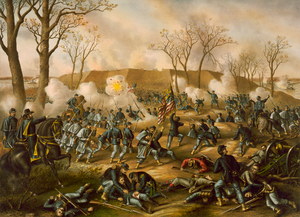Battle of Fort Donelson
| Battle of Fort Donelson | |||||||
|---|---|---|---|---|---|---|---|
| Part of the American Civil War | |||||||
 Battle of Fort Donelson, by Kurz and Allison (1887). |
|||||||
|
|||||||
| Belligerents | |||||||
|
|
|
||||||
| Commanders and leaders | |||||||
|
Ulysses S. Grant Andrew H. Foote |
John B. Floyd Gideon J. Pillow Simon B. Buckner (POW) |
||||||
| Units involved | |||||||
|
|
||||||
| Strength | |||||||
| 24,531 | 16,171 | ||||||
| Casualties and losses | |||||||
|
2,691 total (507 killed 1,976 wounded 208 captured/missing) |
13,846 total (327 killed 1,127 wounded 12,392 captured/missing) |
||||||
The Battle of Fort Donelson was fought from February 11 to 16, 1862, in the Western Theater of the American Civil War. The Union capture of the Confederate fort near the Tennessee–Kentucky border opened the Cumberland River, an important avenue for the invasion of the South. The Union's success also elevated Brig. Gen. Ulysses S. Grant from an obscure and largely unproven leader to the rank of major general, and earned him the nickname of "Unconditional Surrender" Grant.
The battle followed the Union capture of Fort Henry on February 6. Grant moved his army 12 miles (19 km) overland to Fort Donelson on February 12 and 13 and conducted several small probing attacks. (Although the name was not yet in use, the troops serving under Grant were the nucleus of the Union's Army of the Tennessee.) On February 14, Union gunboats under Flag Officer Andrew H. Foote attempted to reduce the fort with gunfire, but were forced to withdraw after sustaining heavy damage from Fort Donelson's water batteries.
On February 15, with the fort surrounded, the Confederates, commanded by Brig. Gen. John B. Floyd, launched a surprise attack against the right flank of Grant's army in an attempt to open an escape route to Nashville, Tennessee. Grant, who was away from the battlefield at the start of the attack, arrived to rally his men and counterattack. Despite achieving partial success and opening the way for a retreat, Floyd lost his nerve and ordered his men back to the fort. The following morning, Floyd and his second-in-command, Brig. Gen. Gideon J. Pillow, escaped with a small detachment of troops, relinquishing command to Brig. Gen. Simon Bolivar Buckner (later Governor of Kentucky), who accepted Grant's terms of unconditional surrender later that day.
...
Wikipedia
